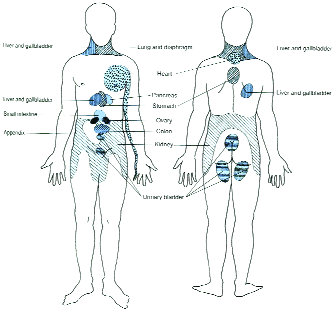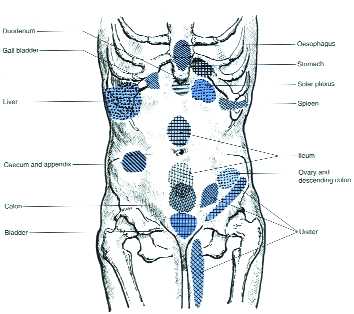Positive Health Online
Your Country

The Importance of Palpatory Skills
by Mario-Paul Cassar(more info)
listed in bodywork, originally published in issue 104 - October 2004
It is reasonable to assume that palpatory skills are vital to any massage therapy and bodywork. Competence and dexterity are required not only for the purpose of assessing the tissues but also to manipulate them and therefore in carrying out the treatment.
Establishing the cause of pain is the primary aspect of any treatment. In addition to testing for any strains and other injuries it is therefore crucial to assess for any changes, and their causes, in the somatic tissues.
Palpation can be carried out without the use of massage oils or cream; this is indeed an excellent method for developing sensitivity in the hands. Observation and evaluation are then continued throughout the massage treatment, even with the tissues lubricated. A sensitive and confident touch is essential to palpatory skills. Having relaxed hands is an additional requirement and helps to enhance their sensitivity.
Palpation is done mostly with the pads of the fingers, as these zones are very responsive; however, the whole region of the hand is very often involved in the process of 'feeling' the tissues as well as applying the pressure. This two-way action, evaluating the tissues whilst exerting pressure, is the very crux of the massage treatment.
The depth of the palpation varies with the tissues being targeted; a light touch is needed for the superficial tissues whilst a slightly heavier pressure is applied for some of the viscera and deeper muscles. If any abnormalities are palpated, it is imperative to establish whether the deviations are in the superficial fascia, the muscles, bones or an organ. Ascertaining the tissue layer helps to assess the probable changes; for example, a nodule in a muscle, scar tissue in the superficial fascia, a thickening of a bony surface, or compacted matter in the colon. This continual adjustment of the pressure to suit the state of the tissues is essential for all massage strokes.
The methodology and interpretation of soft tissue assessment are based on the principles of long-established massage and bodywork modus operandi, such as neuromuscular technique and connective tissue massage.
Mutual to most of these procedures are reflex pathways, hypersensitive reflex zones, nodules, trigger points and so forth. For those practising massage, bodywork and manipulative therapies, these somatic dysfunctions are vital to the assessment of musculoskeletal integrity.
Somatic Dysfunction
Changes in the tissues can occur when the body is subjected to stressors, and these may be chemical, mechanical or emotional. A typical stressor is an organ that is malfunctioning. Musculo-skeletal dysfunctions such as tissue strains and spinal dysfunctions are also common causes. As a result of these stressors the peripheral tissues undergo changes which can be observed and palpated; these include congestion, muscle spasm, adhesions and oedema (see Table 1). Such abnormalities or dysfunctions of the peripheral tissues will themselves act as stressors and create further imbalances.
Table 1
Examples of somatic dysfunction in reflex zone areas• Muscle spasm;
• Contractures in the fascia or muscles;
• Fibrotic tissue;
• Reduced skin elasticity accompanied by ‘skin drag’;
• Sweating;
• Increased or reduced skin temperature;
• Nodules;
• Hypersensitivity;
• Adhesions;
• Congestion;
• Oedema;
• Hypotonic states;
• Atrophy;
• Bony thickening.
A good example of a stressor is an organ that is malfunctioning. This can have two effects on the peripheral tissues:
1. A direct referred pain, usually felt in a dermatome, myotome or bony tissue which is supplied by the same nerve root as that of the malfunctioning organ. The pain is generally present without any palpation; for example, the painful abdomen associated with appendicitis. A chart of referred pain areas is shown in Figure 1.

Areas of referred pain
2. Indirect tissue changes in the periphery (Reflex Zones). Changes in the somatic tissue are brought about by an indirect connection to the nerve supply of the malfunctioning organ, or by an impaired circulation to the tissues. As a result, the somatic connective tissues undergo changes such as tightness, congestion and thickening; they are generally a source of pain on palpation. This is invariably worse with movement or contraction of a muscle. A dysfunctioning visceral organ will often lead to a painful stimulus, but this is not always felt in the organ itself. Through the reflex mechanisms, the malfunction creates changes in the myotomes leading to muscle spasms, and also in the dermatomes causing hyperaesthesia of the overlying superficial tissues. The treatment of somatic dysfunction is carried out with massage, neuromuscular technique and bodywork movements. The aim and purpose of the treatment is to reduce the hypersensitivity, improve the local circulation, reduce the tension and restore the normal length, flexibility and mobility of the tissues involved. In so doing the reflex pathways are also affected and this in turn helps to normalize the function of the associated organ, or the musculo-skeletal imbalances.

Reflex zones of the abdomen (after MacKenzie, 1923)
Illustration Source: Handbook of Clinical Massage, Churchill Livingstone
Comments:
-
No Article Comments available